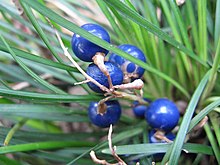Ophiopogon japonicus
| Ophiopogon japonicus | |
|---|---|
 |
|
| Fruit, close-up | |
| Scientific classification | |
| Kingdom: | Plantae |
| Clade: | Angiosperms |
| Clade: | Monocots |
| Order: | Asparagales |
| Family: | Asparagaceae |
| Subfamily: | Nolinoideae |
| Genus: | Ophiopogon |
| Species: | O. japonicus |
| Binomial name | |
|
Ophiopogon japonicus (L.f.) Ker Gawl. |
|
Ophiopogon japonicus (dwarf lilyturf,mondograss, fountainplant, monkeygrass; Japanese: リュウノヒゲ ryu-no-hige ("dragon's beard") or ジャノヒゲ ja-no-hige ("snake's beard")) is a species of Ophiopogon native to China, India, Japan, and Vietnam.
It is an evergreen, sod-forming perennial plant. The leaves are linear, 20–40 cm long. The flowers are white through pale lilac, borne in a short raceme on a 5–10 cm stem. The fruit is a blue berry 5 mm diameter. Underground, this species has large stolens with tuberous roots.
It is grown as an ornamental plant, providing an excellent groundcover. Several cultivars have been selected, including 'Albus' (white flowers), 'Compactus' and 'Kyoto Dwarf' (dwarf forms, not over 4–5 cm tall), and 'Silver Mist' (variegated, with white-striped leaves). It is often sold as a decorative plant for freshwater aquaria, but because it is not a true aquatic plant, it can live for a few months underwater before it dies. While hardy to temperatures of about -20 °C when dormant in winter outdoors in normal soil, when kept fully submerged it requires water temperatures of 18-25 °C. It grows well in full sun or partial shade. Propagation is from side shoots.
In traditional Chinese medicine Ophiopogon japonicus tuber, known as mai men dong (Chinese: 麥門冬), is the cardinal herb for yin deficiency. According to the "Chinese Herbal Medicine Materia Medica," the herb is sweet, slightly bitter and slightly cold, enters the heart, lung, and stomach channels and nourishes the yin of the stomach, spleen, heart, and lungs and clears heat and quiets irritability. Liriope spicata is used as a substitute.
...
Wikipedia
